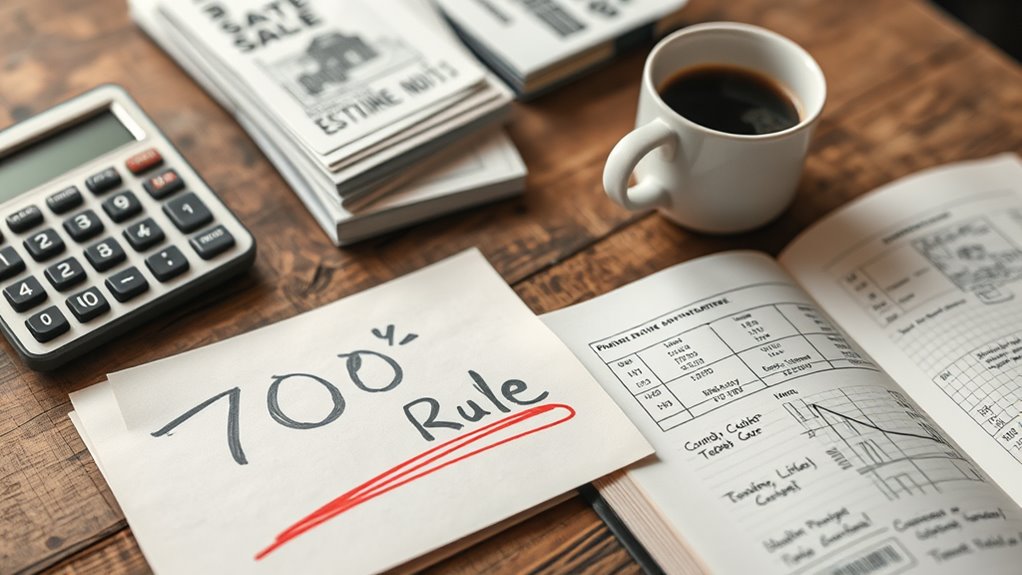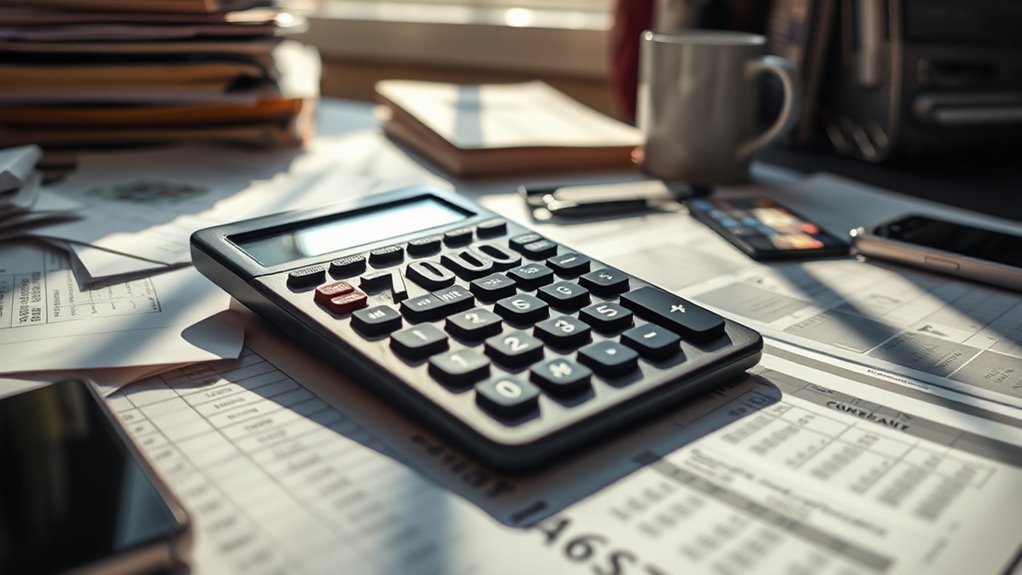To apply the 70 percent rule in real estate wholesaling, first determine the ARV by analyzing comps of similar renovated properties. Multiply the ARV by 70% to set your maximum allowable offer. Then subtract estimated repair costs to guarantee a solid profit margin. This rule protects your investment but may need adjustment in competitive markets. Understanding local trends and accurately calculating costs will keep you ahead. Stick with us to uncover deeper strategies for securing profitable deals.
Key Takeaways
- Calculate ARV by analyzing recent sales of similar rehabbed properties in the area.
- Multiply ARV by 70% to determine the maximum allowable purchase price.
- Subtract estimated repair costs from 70% of ARV to set a profitable offer.
- Adjust offers in competitive markets, potentially increasing to 80-85% of ARV.
- Use accurate comps and repair estimates to ensure deals align with the 70% rule.
Understanding ARV and As-Is Value
ARV’s importance in real estate wholesaling can’t be overstated—it’s the projected value of a property after repairs are made, based on recent sales of comparable homes in the area. To determine ARV accurately, you’ll analyze comparable sales (comps) of similar properties post-rehabilitation. This gives you a clear picture of what the property could fetch once it’s market-ready. Equally critical is the as-is value, which reflects the property’s current condition, often lower due to needed repairs or market factors. As a wholesaler, you’ll use the as-is value to negotiate a purchase price that leaves room for profit. Understanding both ARV and as-is value is essential for evaluating whether a deal aligns with the 70 percent rule. By studying recent sales and examining the property’s current condition, you’ll position yourself to make strategic offers that maximize profitability while minimizing risk. Mastery of these values guarantees you’re targeting deals with solid potential. Current market trends play a crucial role in ensuring your ARV estimates remain relevant and reliable.
70 Percent Rule in Real Estate Wholesaling

Once you’ve determined a property’s ARV and as-is value, you’ll need a reliable method to calculate your maximum allowable offer. The 70% rule is a cornerstone strategy in real estate investments, ensuring you don’t overpay while leaving room for profit. Start by multiplying the ARV by 70%, then subtract the estimated repair costs. For example, a property with an ARV of $200,000 and $30,000 in repairs would yield a maximum offer of $110,000. This rule safeguards your investment by accounting for both your profit margin and the flipper’s profit when wholesaling. It’s a disciplined approach that protects you from overextending on a deal. However, in competitive markets, you might need to adjust the rule, pushing your offer closer to 80-85% of the ARV to secure the property. Always balance market conditions with the fundamentals of the 70% rule to maximize success in real estate investing. Thorough research is essential before calculating your maximum allowable offer to ensure accurate financial projections.
Comps and Repair Cost Deduction

When determining the maximum allowable offer for a property, accurately estimating the After Repair Value (ARV) and repair costs is critical. Start by pulling comps—recently sold properties with similar size, condition, and location—to establish a realistic ARV (after repair value). Avoid using pre-ARV sales or investor sales, as they won’t reflect the true market value of your renovated investment property. Once you’ve nailed down the ARV, calculate the estimated rehab costs, including labor, materials, and permits. Deduct these renovation costs from 70% of the ARV to determine your maximum price. This guarantees you’re not overpaying while leaving room for profit. As a house flipper or property owner, precision in these steps is non-negotiable. Overestimating the ARV or underestimating repair costs can derail your real estate deal, so always double-check your numbers to stay competitive and profitable. Ensure comps are within a 1-mile radius to align with standard market trends and pricing accuracy.
Wholesaler Considerations

While wholesalers aim to secure properties at below-market prices, their success hinges on identifying motivated sellers and accurately evaluating potential deals. To secure favorable deals, focus on sellers who need to offload properties quickly due to financial distress, inheritance, or other pressing circumstances. These motivated sellers are more likely to accept lower contract prices, guaranteeing your profitability when reselling to investors. Always assess property issues thoroughly; understanding the extent of repairs needed allows you to factor repair costs into your offer, minimizing risks. Accurately estimating the ARV is critical—this confirms you’re basing your offer on a realistic resale value. By keeping contract prices well below ARV minus repair costs, you create room for profit while appealing to buyers. Avoid overcommitting to extensive repairs; wholesalers thrive by purchasing properties as-is and passing them on quickly. Your ability to evaluate deals strategically will determine your success in wholesaling properties. Adhering to the 70% rule ensures a buffer for unexpected costs and maximizes profitability.
Local Market Awareness

Local market awareness is the backbone of successful real estate wholesaling. To thrive, you’ve got to understand neighborhood trends, property values, and buyer demand. These factors directly impact your ability to accurately assess ARV and repair costs, ensuring you stay within the 70 percent rule. Start by researching comparable properties (comps) to gauge the after-repair value, but be cautious—investor activity can skew comps, as their sales often reflect lower prices than retail. Don’t rely solely on data; conduct ground-level research. Drive through neighborhoods, speak with local agents, and observe economic factors like job growth or school quality, which influence buyer demand. This hands-on approach gives you a competitive edge, helping you spot undervalued opportunities and predict market shifts. Knowledge of vacancy rates can further inform your investment strategy, as they indicate housing availability and market saturation. By mastering your local market, you’ll make smarter deals, minimize risks, and maximize profits.
 Conclusion
Conclusion
Master the 70% rule to maximize your margins, minimize your mistakes, and move properties profitably in wholesaling. Careful calculations of ARV and as-is value, combined with correct comps and cost deductions, craft clear-cut deals. Stay savvy about local market shifts to secure success. Strategic, swift, and smart application guarantees you edge out the competition and elevate your earnings. Push past pitfalls by practicing precision—your path to prosperity starts with this principle.




